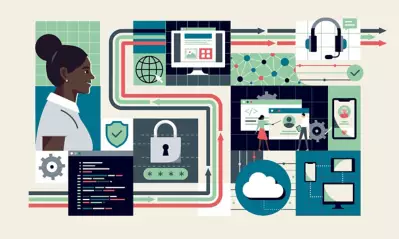Articles > Cybersecurity >ĚýWhat is data governance?
What is data governance?

Written by Michael Feder

Reviewed byĚýKathryn Uhles, MIS, MSP,ĚýDean, College of Business and IT

As the international big data market could reach a by 2026, initiatives to keep data safe will play a growing role, guiding how companies learn from the data assets they collect. This means experts with experience and education in data science and data governance tools will be in demand, expanding the field of data science careers.
What is data governance vs. data management
The definition of what is data governance refers to the policies that determine how employees manage information across a company. It combines an organization’s standards on data collection, data quality, storage and ethical use into a unifiedĚý framework. As the primary data stewards, company stakeholders consult their these policies and strategies when making decisions and determining how to respond to risks.
Data management and governance are similar but unique fields. A data governance framework determines how employees use data.ĚýData management is the actual set of processesĚý— often including governance tools — that collect and analyze data assets across the organization.
Without governance, data management would be ineffective. The former outlines the standards for proper data collection, states where data should be stored and why and how data should be used. Data management operates on top of that foundation and includes actions like data analysis, security and integration.
Key elements of a data governance framework
A company’s data governance framework includes several key fields. Together, these fields identify how employees should navigate all data — whether the information is generated by employees or customers. Most of these frameworks include elements like data quality and consistency, data security and data ownership.
Data quality and consistency
A high level of data consistency and quality is encouraged across a company. A good strategy streamlines the process by treating all data the same — whether it’s through protection, collection or the actual use of data. This helps minimize data usage errors and protects data quality as employees use and share it.
This is applicable for companies of all sizes, particularly in labeling. Employees should use consistent labeling strategiesĚýthat help identify the data source, use and required security. Universal labeling standards allow employees of different departments to share data. They also reduce misunderstandings when one employee collects data and another uses it.
Compliance and regulatory requirements
One major feature of what is data governance involves compliance — ensuring that employees use data following protection regulations. These regulations outline acceptable ways that companies can navigate data — from collection through disposal. They also identify ways a company can manage data subject rights and obtain consent from customers during the data collection process.
Regulatory requirements often include the EU's General Data Protection RegulationĚýand theĚý, both of which dictate acceptable ways to use personal data.
Data security and data privacy
Many governance procedures also feature sections on security and privacy. This includes guidelines on how to identify sensitive information within a company’s data catalog and take steps to protect it.
Data security and privacy strategiesĚýshare a common goal: prevent data loss and misuse. This includes strategies to help prevent data loss, including regular audits on companywide data usage habits. It also includes education that teaches employees how to be good data stewards who use collected data ethically. These same policies set controls on data access so that employees can handle only the data they need to.
Data ownership
What is data governance's way of identifying data owners? This includes employees who need access to specific data sets. Policies sets limits on which data certain employees can access. IT teams follow these accountability and data stewardship standards when setting data access permissions across a company.
Data ownership limits the data an employee can access. It allows employees to see, use and share the information they need without granting them access to information they won’t use. This data stewardship practice limits overall data sharing and creates transparency and accountability in how each employee uses the information a company stores.
Tools and technologies
Companies use a wide variety of resources to support their data governance framework. Here are some types of these tools that companies can use when fulfilling data management processes:
- Data cataloging: Tools that create a single destination for all stored data. They make it easy for employees to find data points, even if they don’t know exactly where to find them. Companies depend on tools like Informatica, Alation and Qlik to securely collect and organize data no matter its original location.
- Data modeling: Tools that help companies better understand the data they collect and add to their data catalog. These resources showcase new insights from information, often in a graphic or infographic format. Companies depend on Lucidchart, Archi, Apache Spark and other data modeling tools to highlight new trends in collected data.
- Data quality management: Data stewardship tools that help company stakeholders maintain quality of their data assets over time. They might offer features in data cleansing, storage or monitoring. Tools like OpenRefine, Talend and Precisely help companies manage and manipulate large data sets in seconds.
These tools help companies better understand the scope and purpose of the data they collect. They can also minimize the possibility of user error when employees access specific pieces of data.
What is data governance's importance in business intelligence and analytics
Executives make fundamental decisions based on data. They might create new products, hire employees or invest funding based on the data they collect. This is an important part ofĚýbusiness intelligence.ĚýIt plays a role in creatingĚýanalysis strategiesĚýthat help executives make data-driven decisions. When company stakeholders access data, governance processes ensure that information in the data catalog is accurate, reliable and consistent.
Every stage of stakeholder decision-making can be included. It provides executives with the right data at the right time and protects that data while in use. It also allows for easy data sharing between different executives. Most importantly, it supports data quality — helping company leaders make informed decisions during the business intelligence and analytics process.
Implementing a data governance program
There are many factors to consider when planning a governance program. For example, companies should plan out a strategy for data collection and storage. They should also determine how the information will be disposed of after use.
Here are some other priorities for businesses to consider when implementing a program:
- Goals and objectives:ĚýIdentify specific business outcomes the company wants to achieve by collecting data. Outline how a data governance program will protect those interests as data is collected.
- Establish a program structure:ĚýAssign roles and reporting for the data collection and usage process. A company’s primary data stewards should understand their responsibilities in gathering, analyzing and securing data.
- Identify existing data:ĚýAudit how well the company has collected data over time. Determine if the company already possesses some of the data that is needed.
- Define acceptable data usage policies:ĚýCreate policies that ensure data is only used in ethical ways. Make sure employees understand these policies and the consequences if data is used incorrectly or shared outside of appropriate access permissions.
Data governance doesn’t end after data collection. Companies should monitor how employees use data to find opportunities for improvement. This often means collecting feedback from employees, particularly feedback that identifies how well they can manage data using the current data governance policies.
Learn more about what is data governance
If you’re interested in learning more about what is data governance and perhaps pursuing a career in data, ąű¶łĘÓƵ offers aĚýBachelor of Science in Data Science.ĚýĚý
Contact ąű¶łĘÓƵ for more information.

ABOUT THE AUTHOR
A graduate of Johns Hopkins University and its Writing Seminars program and winner of the Stephen A. Dixon Literary Prize, Michael Feder brings an eye for detail and a passion for research to every article he writes. His academic and professional background includes experience in marketing, content development, script writing and SEO. Today, he works as a multimedia specialist at ąű¶łĘÓƵ where he covers a variety of topics ranging from healthcare to IT.

ABOUT THE REVIEWER
Currently Dean of the College of Business and Information Technology,ĚýKathryn Uhles has served ąű¶łĘÓƵ in a variety of roles since 2006. Prior to joining ąű¶łĘÓƵ, Kathryn taught fifth grade to underprivileged youth in Phoenix.
This article has been vetted by ąű¶łĘÓƵ's editorial advisory committee.Ěý
Read more about our editorial process.
Get your free IT Program Guide
Learn how 100% of our IT degree and certificate programs align with career-relevant skills.
Get your free IT program guide. Please enter your first and last name.
Thank you
Download your pdf guide now. Or access the link in our email.


